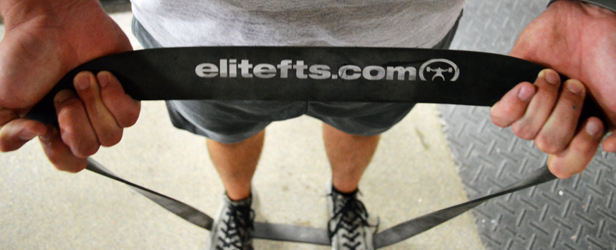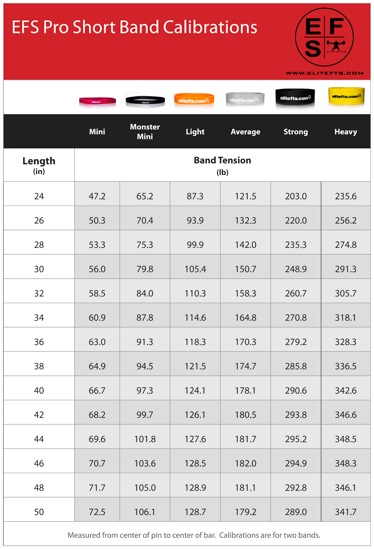
Bands were first introduced to Dave Tate close to 10 years ago. After experimenting with accommodating resistance and the use of chains, Dave took his squat from 760 to 855 in 12 months. With his new success, he was hesitant to use any other method. Over the years lifters and coaches have been attaching exercise bands to weighted barbells with amazing results, and the results have sustained the test of time.
Bands have come a long way since then and at EFS, they have now evolved into EFS Pro Short Bands.
Benefits of EFS Pro Short Bands
- Easy to set up
- No need for a platform for band deadlifts
- Balanced tension
- Heavier ones have a wider base compared to double looping or quad looping the bands (this can cause them to shred)
Why were they made?
A lot of time could be saved if you didn’t have to spend 50 million attempts trying to double-up the bands so that they are even. After years of frustration, it was time to make shorter bands with the same resistance as doubled bands.
How do they work?
When bands are used, there is more weight pulling you to the floor than without the bands, causing a form of maximal eccentrics.
There are many ways you can implement them into your bench training using dynamic, max effort and submaximal methods. Below are some examples:
Dynamic Bench Cycle
Week 1 – 50% for 8 sets 3 reps (use three different grips: close, medium and wide)
Week 2 – 50% for 8 sets 3 reps (use three different grips: close, medium and wide)
Week 3 – 50% for 8 sets 3 reps (use three different grips: close, medium and wide)
· If you feel good and the weight feels easy, add two sets of five reps at the end of the eight dynamic speed sets, with a weight 10-20% higher than the weight used for your dynamic sets.
Sample Max Effort Bench Application
Select a band tension close to or equal to 50% of your best bench press to perform a three-board press with bands. Load the bands on the bar first and work up to a one or three rep max. This is a great movement for lockout and tricep strength.
A Note on Submaximal Bench Training With Bands
While there are many ways to skin a cat, Dave suggests a reduction of barbell weight equal to the band tension at the bottom of the lift. So if your training weight is programmed to be 300 for 2 sets of 5 reps and the band tension at the bottom is 40 pounds, he suggests you lower the barbell weight to 260 pounds.
There are also many ways to use the band for training the deadlift, but two of the most popular are: max effort pin pulls from a pin below the knees and speed pulls from the floor.
Pin Pulls With Bands
Select a band tension equal to 40-50% of your best deadlift off the floor. Load the band to the bar first and work up to a one rep max.
Speed Pulls
Select a band tension close to 50-60% of the weight you will be using for your dynamic (speed work). Most lifters tend to use a weight between 40 and 60 percent of the best one rep max for speed work. If your max pull is 600 pounds then your training weight would be 300 and your band tension 150 pounds at the top (or whatever works out closest). You will then do 6-10 sets of one rep.
The Tension Chart
Mike Lawrence, a Ball State University biomechanics laboratory graduate assistant, conducted a study on our EFS Pro Short Bands. He tested the bands when they are stretched from 24-50 inches. Every two inches, he calculated the amount of force in pounds the mini bands produce.
The distance Mike measured is the distance from the center of the end of the bar to the center of the peg. The bands were put around the bar on the inside of the collars. If the bands are put on the collars, it may add a few pounds.
The bands show less force as they are stretched more towards the end of the calibration, Mike said. The picture below shows what the force curve for bands will look like.
All of his measurements took place between the band being slack and point B on the curve. This is the range around where the bands will be stretched for benching. Mike does not recommend stretching the black and yellow bands past 48 inches.
“What I wasn’t expecting is that the curve would start to increase so dramatically towards the end,” Mike said.
Sample Movements









